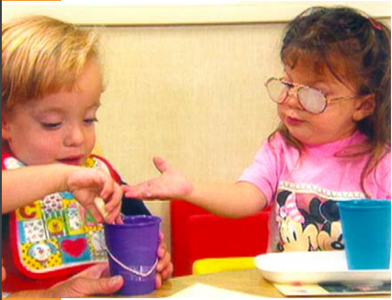26.2: Overview
- Page ID
- 142763
Overview of Inclusive Care
Children with disabilities or other special needs refer to children with a specific diagnosis and children who do not have a diagnosis but whose behavior, development, or health affect their family's ability to maintain child care services. The disability or special need may be as mild as a slight speech delay or as complex as a mixed diagnosis of motor challenges, vision impairment, and cognitive delays.[1] Special health care needs include a variety of conditions such as birth defects, neurological disorders, and chronic illnesses that can be life-threatening or impact daily living (e.g., cancer, sickle cell disease [or anemia], cystic fibrosis, hemophilia, AIDS, diabetes, juvenile rheumatoid arthritis).[1] [2]
Families of children with disabilities or other special needs have the same need for childcare as other families. However, families of children with disabilities or special needs often find the search for quality and affordable child care a more significant challenge as they face the reluctance of many child care providers to enroll their children. This situation makes it all the more important that child care providers strive to include all children in their programs not to increase the immense challenges that such families already face.[3]
Only about 10 percent of eligible infants and toddlers with developmental delays nationwide receive early intervention services, which are widely agreed to reduce delays and lessen the adverse effects of risk factors and disabilities on learning and development. California serves fewer children than the national average. Challenges arise from spotty screening, tenuous linkages to referral and evaluation, and the intricacies of crossing multiple agencies—sometimes without the knowledge of English—for families. [4]
Following the Individuals with Disabilities Education Act (IDEA), children ages 3-21 are entitled to a free, appropriate public education (FAPE) in the least restrictive environment (LRE). LRE requires that, to the extent possible, children with disabilities should have access to the general education curriculum, along with learning activities and settings available to their peers without disabilities. Corresponding federal legislation applied to infants and toddlers (children birth to 3) and their families specifies that early intervention services and supports must be provided in "natural environments," generally interpreted to mean a broad range of contexts and activities that generally occur for typically developing infants and toddlers in homes and communities.[5] [6]
Children with disabilities or other special needs and their families must be included in quality early childhood education programs that are the natural environments of their typically developing peers. Children learn from their interactions with other children and their surroundings while creating a sense of security and self-esteem from caring relationships with program providers and staff. Everyone benefits from quality early childhood education programs that provide inclusive care. Children who have a disability or special need get to know and interact with typically developing peers, while their families benefit from programs and services they need to achieve their parenting goals. Children who are typically developing benefit when they have the opportunity to get to know peers who are atypically developing in the classroom. Everyone has the opportunity to learn about other human beings regarding their strengths and challenges.

Children and families want to be accepted and included in their community regardless of ability. They want to belong. But the kind of belonging they desire goes beyond simply "being together." They want full, unconditional membership in family and community. As Norman Kunc, a disability rights advocate, said so eloquently, "When inclusive education is fully embraced, we abandon the idea that children have to become 'normal' to contribute to the world. Instead, we search for and nourish the inherent gifts in all people. We begin to look beyond typical ways of becoming valued members of the community and, in doing so, begin to realize the achievable goal of providing all children with an authentic sense of belonging."[6]
Children with disabilities or other special needs may present unique challenges, but the care they need is very similar to any child. Children with special needs spend most of their time doing what other children do. They have the same curiosity, desire to play, and need to communicate as their peers do. Childcare providers providing developmentally appropriate childcare, which is individualized to meet the needs of every child, already have many of the skills needed to serve children with disabilities or other special needs.[7]
Infant and toddler caregivers may be involved with families at the time when children's disabilities and developmental concerns are first identified and as interventions begin. This process can be emotional for families, but child care providers can offer valuable insight and be supportive partners. They can play a key role by working with children, families, and other professionals in the early intervention process. A caregiver who actively participates in children's development, learning, and growth supports families in important ways.[8]
[1] Family Partnerships and Culture by the California Department of Education is used with permission
[2] Chapter 15: Families of Children with Special Needs or Special Health Care Needs by Krischa Esquivel; Emily Elam; Jennifer Paris; and Maricela Tafoya CC BY.
[3] Inclusion Works! By the California Department of Education is used with permission ↵
[4] Author Nancy Hunt California State University. (n.d.). Pace - identifying young children for early intervention in California. Policy Analysis for California Education. CC BY
[5] DEC/NAEYC. (2009). Early childhood inclusion: A joint position statement of the Division for Early Childhood (DEC) and the National Association for the Education of Young Children (NAEYC). Chapel Hill: The University of North Carolina, FPG Child Development Institute. Retrieved
[6] Chapter 15: Families of Children with Special Needs or Special Health Care Needs by Krischa Esquivel; Emily Elam; Jennifer Paris; and Maricela Tafoya CC BY
[7] Child Development Resources by the California Department of Education is used with permission ↵
[8] U.S Department of Health and Human Services, Administration for Children and Families, n.d., Creating Inclusive Environments and Learning Experiences for Infants and Toddlers is in the pubic domain

